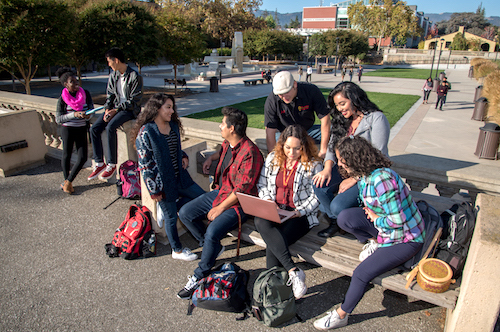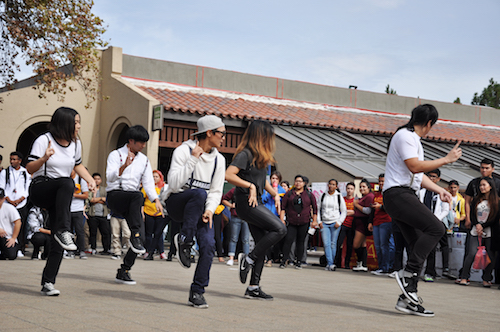A Beautiful and Vibrant Campus

The college profile includes the following sections
- An Unparalleled Opportunity
- Educational Excellence
- Student-Centered Instruction
- Equity, Social Justice and Diversity
- A Beautiful and Vibrant Campus
On a typical day, the De Anza campus is buzzing with activity. But there are also quiet spots for outdoor study and contemplation, including natural gardens with mature trees, peaceful fountains, outdoor murals and sculptures, scattered among the college’s buildings and labs.
A focal point of the campus is the Main Quad, often bustling with students and organized activities such as the quarterly Club Day, student project fairs, the collegewide Welcome Day event each fall, and a spring open house for prospective students and their families. Facing the quad are the Library, Campus Center and Administration buildings. Visitors to the Administration Building lobby can view paintings and sculptures as part of a self-guided walking tour that also highlights numerous outdoor artworks.
In recent decades, De Anza has expanded and upgraded its campus extensively, thanks in large part to community support for three bond measures. The first two measures, approved in 1999 and 2006, provided funds for construction of new buildings and renovation of existing facilities, including technology upgrades in the Library and numerous classrooms.
Additional projects included installation of solar energy arrays and restoration of two historic structures that date from the time when De Anza’s campus was part of an agrarian estate. These are the old stone Baldwin Winery building, which now houses the Financial Aid Office and part-time faculty offices, and the 120-year-old Le Petit Trianon building, home to the California History Center.
More recently, a successful 2020 bond measure provided new funds for upgrading classrooms and infrastructure; building new facilities for athletics and student services; and removing the Flint Center, an aging performance venue that had become seismically unsafe. The college is now engaging with the Foothill-De Anza district and campus constituencies in a process for deciding how to best use the Flint site.
Among existing campus buildings are nine that have been certified as meeting national Leadership in Energy and Environmental Design (LEED) standards for energy efficiency and sustainability. Two of these – the Kirsch Center for Environmental Studies and the Media & Learning Center – have attained LEED Platinum status, the highest rating for sustainable construction and design.
The Kirsch Center was the first “green” demonstration building in the California community college system. Home to the Environmental Studies Department, it sits alongside the 1.5-acre Cheeseman Environmental Study Area, a lush natural garden and outdoor classroom containing more than 400 species of plants, which is used for research and study by the Environmental Studies and Biology departments.
De Anza also boasts a 5,000-seat stadium and a separate aquatics complex, with Olympic-size pool, that regularly hosts intercollegiate swimming and diving competitions.
Other campus landmarks include the De Anza Planetarium, one of the largest school facilities of its kind in the western United States, and the Visual & Performing Arts Center, which includes a 400-seat theater and the Euphrat Museum of Art. The latter is a campus and community resource that regularly hosts unique exhibitions of student and professional artwork, spoken word performances and open mic events, along with classes and other events.
Both the Planetarium and the Euphrat are overseen by De Anza’s Community Education Division, which serves more than 30,000 adults and children from the surrounding communities each year. Its programs also include the De Anza College Academy, which offers enrichment and recreational classes for students in middle and high school, and the Child Development Center, which provides child care for toddlers and preschoolers from families affiliated with De Anza as well as the general public. The center is also a teaching lab for students in De Anza’s Child Development and Education Department.


